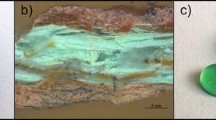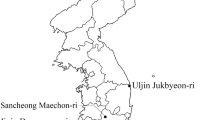Abstract
The phase composition and structural state of a red pigment (ceramics) related to the late Stone Age, found in the archaeological excavation Kfar HaHoresh (Izrael), have been investigated using X-ray diffraction (XRD) analysis and Mössbauer spectroscopy. A clay sample from this excavation was also analyzed to understand the nature of the structural and phase transformations leading to the formation of this ceramics. The phase transformation processes occurring upon heating clay have been modeled, and some conclusions about possible manufacturing technology conditions for the ancient ceramics are drawn.
Similar content being viewed by others
Avoid common mistakes on your manuscript.
INTRODUCTION
The art of transforming clay into ceramic products by firing is one of the most ancient handicrafts of mankind. Pottery had facilitated the development of agriculture, cattle breeding, civil engineering, and artworks. Based on the technical and artistic data on hand-made products, one can estimate the development level of ancient communities that did not leave any historical documentation [1]. The object of our study was the phase composition of a red pigment sample found in the archaeological excavation Kfar HaHoresh (Izrael). This sample, dated to the late Stone Age (9600–6400 BC), is a piece of brittle reddish ceramics. To perform a comparative analysis and estimate the ceramics formation conditions, the phase composition and thermal stability of a clay sample from the same excavation were also investigated.
The purpose of the work was to analyze the phase transformations occurring in clay during when manufacturing ceramics in the late Stone Age epoch in order to obtain data on the most ancient fabrication technology of ceramic products.
EXPERIMENTAL
The archaeological clay and pigment samples under study contain minerals of various nature, which differ in structure, degree of dispersivity, and magnetic properties. A set of physical methods was applied to carry out a phase analysis of these complex multicomponent systems.
X-ray diffraction (XRD) analysis was performed on a PANalytical-Empyrean diffractometer (CuKα radiation). XRD data were collected (voltage 30 kV, current 40 mA) in the angular range from 5° to 90°. Diffraction patterns were processed using the HighScore Plus program (the shape of diffraction lines was described, and their width and intensity were taken into account). Phase analysis was performed using the ICDD database.
To perform qualitative and quantitative analysis of iron-containing phases and estimate the sizes of their particles, Mössbauer spectra of the samples were recorded at room and liquid nitrogen temperatures. The experiments were performed on a standard Mössbauer spectrometer MS-1104Em in the absorption geometry in the velocity range from –12 to +12 mm/s. The recorded Mössbauer spectra were processed mathematically using the “UNIVEM” program.
RESULTS
Some of clay and pigment samples were powdered for XRD analysis. The powders were placed in a nonreflective cell, and their diffraction patterns were recorded (see Fig. 1).
It can be seen in Fig. 1 that the mineral compositions of the samples studied significantly differ. The initial clay sample contains six minerals: quartz, calcite, montmorillonite, magnesiowustite, magnetite, and hematite. A quantitative analysis showed high contents of quartz SiO2 (79 mol %) and calcite (Ca, Mg)CO3 (5 mol %) in it. The iron-containing fraction includes four minerals of different dimensionalities and densities; the total content of four iron-containing minerals is 16% of the total area. The exact ratio between their intensities within the measurement error (±2%) cannot be established. In addition, iron oxide particles are most likely strongly dispersed over the sample. Therefore, the iron-containing minerals could not be quantitatively analyzed.
A phase analysis of the pigment sample (Fig. 1b) showed the presence of quartz, magnetite, magnesioferrite, and anorthite in it. These compositional changes are due to the thermal treatment of the initial soil. A quantitative analysis of the sample showed the largest percentage of quartz SiO2 (78%) and anorthite CaAl2Si2O8 (10%); the latter mineral plays the role of a strong ceramic framework [2, 3]. The high content of quartz sand in the sample structure provides conditions for forming many fine-grained particles of iron compounds, distributed over its entire volume; this circumstance hinders the XRD phase analysis of the samples. Thus, a highly sensitive method of Mössbauer spectroscopy was applied to perform a quantitative phase analysis of iron-containing minerals and estimate their particle sizes.
The room-temperature Mössbauer spectra of the samples (Fig. 2) showed the presence of goethite, magnetite, hematite, magnesiowustite, and montmorillonite in the soil sample; the red pigment sample was found to contain hematite and magnesioferrite [4]. The spectral-component parameters obtained by mathematical processing are listed in Tables 1 and 2. Both spectra have a strong paramagnetic doublet component. However, its intensity in the red pigment spectrum is lower due to the destruction of layered argillaceous mineral montmorillonite ((Na,Ca)0.33Fe2((Si,Al)4O10)(OH)2nH2O) and occurrence of the magnesiowustite–magnesioferrite transition. The decomposed spectrum of soil sample contains doublets whose parameters are consistent with those of hematite and goethite dispersed nanoparticles, whereas the red pigment spectrum contains a doublet with parameters corresponding to those of nanosized hematite [5]. The high sand content in both samples provides conditions for dispersion of many iron oxide nanoparticles, distributed over their entire volume; therefore, relaxation subspectra are absent in their general spectra.
Figure 3 shows the liquid nitrogen-temperature Mössbauer spectra of the samples. Tables 1 and 2 contain parameters of the spectral components obtained by mathematical processing. The liquid nitrogen-temperature spectra demonstrate the same changes for the soil and pigment samples: increase in the intensity of the subspectra with magnetic hyperfine splitting and a decrease in the doublet component intensity. At the same time, there remains an essential doublet part with parameters corresponding to superparamagnetic hematite and goethite. The high percentage of quartz sand in both samples provides conditions for forming many fine-grained iron oxide particles <7 nm in size (hematite and goethite), distributed over the entire sample volume [6]. For this reason goethite was not observed in diffraction patterns.
RESULTS AND DISCUSSION
An increase in temperature led to goethite–hematite and magnetite–hematite structural transformations in the soil sample and caused destruction of layered argillaceous mineral montmorillonite. A thermogravimetric analysis of the clay sample with limited oxygen access [7] showed that the montmorillonite underwent the following changes with an increase in temperature: dehydration; release of structural water; and, finally, complete destruction. These stages occurred in the temperature range of 130–850°C. Destruction of montmorillonite led to the formation of oxides Al2O3, CaO, SiO2, Fe2O3, which gave rise to anorthite CaAl2Si2O8; the latter mineral played the role of a strong framework. The destruction of the montmorillonite structure upon heating leads to release of small superparamagnetic Fe2O3 particles, as a result of which the content of superparamagnetic hematite in the pigment increases. In addition, due to the destruction of montmorillonite structure and occurrence of the magnesiowustite–magnesioferrite transition (the formation temperature is 800°C) [5], the pigment sample demonstrates reduction of the doublet component intensity (as a result of the increase in the intensity of subspectra with magnetic hyperfine splitting, which correspond to hematite and nonstoichiometric magnesioferrite). The hematite content in the sample also increases due to the structural transformations α-FeOOH → α-Fe2O3 and Fe3O4 → Fe2O3.
Mössbauer spectroscopy made it possible to determine quantitatively the content of each iron-containing mineral in the soil and pigment samples. Having combined these results with the XRD data, we arrive at the following pattern (see Fig. 4).
The differences in the Mössbauer spectra of the red pigment and initial soil samples are explained by the structural transformations underwent by the argillaceous soil upon heating. The difference in the Mössbauer spectra of the samples were significantly affected by the transformations of montmorillonite (the main argillaceous mineral in the soil sample) upon heating. As a result of firing the hematite content in the ceramic pigment sample was doubled in comparison with the soil sample; this is the reason for the reddish pigment hue.
CONCLUSIONS
Soil and pigment (ceramics) samples from the Kfar HaHoresh excavation were investigated, their phase composition was determined, and the phase transformations leading to the ceramics formation were analyzed. The fabrication process of ancient ceramics was investigated applying a complex of analytical techniques. Based on the analysis of the temperatures and temperature ranges of all phase transformations responsible for the ceramics formation, the clay firing temperature was concluded to be on the order of 800–850°C. The firing occurred under conditions of limited oxygen access. These data are consistent with the archaeologists’ suggestions [8].
REFERENCES
A. Tsatskin and T. S. Gendler, J. Archaeol. Sci. Rep. 6, 284 (2016).
O. N. Kanygina, A. G. Chetverikova, D. A. Lazarev, and E. V. Sal’nikova, Vestn. Orenburzhskogo Gos. Univ., No. 6, 113 (2010).
I. A. Levitskii, Glass-Ceram., No. 6, 32 (2005).
J. G. Stevens, A. M. Khasanov, J. W. Miller, et al., Mössbauer Mineral Handbook (Mössbauer Effect Data Center, 2005).
A. A. Novakova, T. S. Gendler, N. D. Manuirova, and R. A. Turisheva, Corros. Sci. 39 (9), 1585 (1997).
E. Murad and U. Schwertmann, Am. Mineral. 65, 1044 (1980).
V. O. Denisov and A. A. Novakova, Proc. 52nd School on Condensed State Physics (School CSP-2018), St. Petersburg,2018, p. 98.
Yu. B. Tsetlin, Ceramics: Concepts and Terms of Historico-Cultural Approach (Izd. IA RAN, Moscow, 2017) [in Russian].
Author information
Authors and Affiliations
Corresponding author
Additional information
Translated by Yu. Sin’kov
Rights and permissions
About this article
Cite this article
Novakova, A.A., Denisov, V.O., Boeva, N.M. et al. Study of the Argillaceous Soil and Late Stone Age Ceramics Made of It. Crystallogr. Rep. 65, 376–380 (2020). https://doi.org/10.1134/S1063774520030232
Received:
Revised:
Accepted:
Published:
Issue Date:
DOI: https://doi.org/10.1134/S1063774520030232








